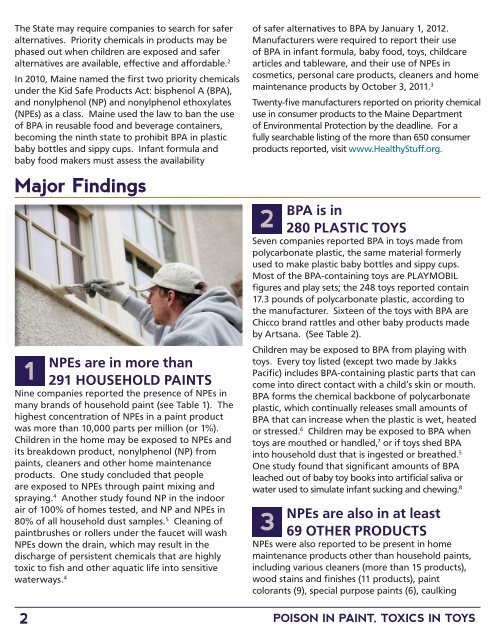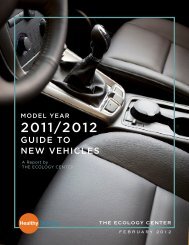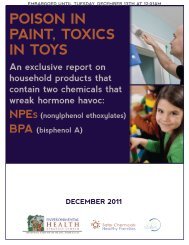POISON IN PAINT, TOXICS IN TOYS - HealthyStuff.org
POISON IN PAINT, TOXICS IN TOYS - HealthyStuff.org
POISON IN PAINT, TOXICS IN TOYS - HealthyStuff.org
You also want an ePaper? Increase the reach of your titles
YUMPU automatically turns print PDFs into web optimized ePapers that Google loves.
The State may require companies to search for safer<br />
alternatives. Priority chemicals in products may be<br />
phased out when children are exposed and safer<br />
alternatives are available, e�ective and a�ordable. 2<br />
In 2010, Maine named the �rst two priority chemicals<br />
under the Kid Safe Products Act: bisphenol A (BPA),<br />
and nonylphenol (NP) and nonylphenol ethoxylates<br />
(NPEs) as a class. Maine used the law to ban the use<br />
of BPA in reusable food and beverage containers,<br />
becoming the ninth state to prohibit BPA in plastic<br />
baby bottles and sippy cups. Infant formula and<br />
baby food makers must assess the availability<br />
Major Findings<br />
1<br />
2<br />
NPEs are in more than<br />
291 HOUSEHOLD PA<strong>IN</strong>TS<br />
Nine companies reported the presence of NPEs in<br />
many brands of household paint (see Table 1). The<br />
highest concentration of NPEs in a paint product<br />
was more than 10,000 parts per million (or 1%).<br />
Children in the home may be exposed to NPEs and<br />
its breakdown product, nonylphenol (NP) from<br />
paints, cleaners and other home maintenance<br />
products. One study concluded that people<br />
are exposed to NPEs through paint mixing and<br />
spraying. 4 Another study found NP in the indoor<br />
air of 100% of homes tested, and NP and NPEs in<br />
80% of all household dust samples. 5 Cleaning of<br />
paintbrushes or rollers under the faucet will wash<br />
NPEs down the drain, which may result in the<br />
discharge of persistent chemicals that are highly<br />
toxic to �sh and other aquatic life into sensitive<br />
waterways. 4<br />
of safer alternatives to BPA by January 1, 2012.<br />
Manufacturers were required to report their use<br />
of BPA in infant formula, baby food, toys, childcare<br />
articles and tableware, and their use of NPEs in<br />
cosmetics, personal care products, cleaners and home<br />
maintenance products by October 3, 2011. 3<br />
Twenty-�ve manufacturers reported on priority chemical<br />
use in consumer products to the Maine Department<br />
of Environmental Protection by the deadline. For a<br />
fully searchable listing of the more than 650 consumer<br />
products reported, visit www.HealthyStu�.<strong>org</strong>.<br />
2<br />
BPA is in<br />
280 PLASTIC <strong>TOYS</strong><br />
Seven companies reported BPA in toys made from<br />
polycarbonate plastic, the same material formerly<br />
used to make plastic baby bottles and sippy cups.<br />
Most of the BPA-containing toys are PLAYMOBIL<br />
�gures and play sets; the 248 toys reported contain<br />
17.3 pounds of polycarbonate plastic, according to<br />
the manufacturer. Sixteen of the toys with BPA are<br />
Chicco brand rattles and other baby products made<br />
by Artsana. (See Table 2).<br />
Children may be exposed to BPA from playing with<br />
toys. Every toy listed (except two made by Jakks<br />
Paci�c) includes BPA-containing plastic parts that can<br />
come into direct contact with a child’s skin or mouth.<br />
BPA forms the chemical backbone of polycarbonate<br />
plastic, which continually releases small amounts of<br />
BPA that can increase when the plastic is wet, heated<br />
or stressed. 6 Children may be exposed to BPA when<br />
toys are mouthed or handled, 7 or if toys shed BPA<br />
into household dust that is ingested or breathed. 5<br />
One study found that signi�cant amounts of BPA<br />
leached out of baby toy books into arti�cial saliva or<br />
water used to simulate infant sucking and chewing. 8<br />
3<br />
NPEs are also in at least<br />
69 OTHER PRODUCTS<br />
NPEs were also reported to be present in home<br />
maintenance products other than household paints,<br />
including various cleaners (more than 15 products),<br />
wood stains and �nishes (11 products), paint<br />
colorants (9), special purpose paints (6), caulking<br />
<strong>POISON</strong> <strong>IN</strong> PA<strong>IN</strong>T, <strong>TOXICS</strong> <strong>IN</strong> <strong>TOYS</strong>




